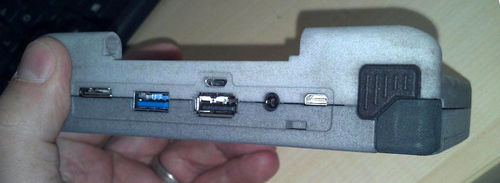USB
The Pyra has four USB ports, as detailed below.
For our purposes:
- "USB2" means "capable of Low, Full and High-speed"
- "USB3" means "capable of low, full, high and super-speed"
- "OTG" means capable of operating in either host- or slave-mode.
Full-size USB2 Port
This is a straightforward USB port as found on many desktop PCs. I can be used for keyboards, mice, USB memory sticks, network adaptors and many other things (subject to driver support)
Full-size USB2 Port with eSATA
This can be used as a simple USB2 port as above. Although this uses a blue connector as designed for USB3 ports, this is not (with the current processor board) capable of USB3. The additional pins are used for SATA signalling to an adaptor. See Storage for more details.
Micro-USB3 OTG Port
This can be used much like the full-size USB2 ports, but at higher speeds and with the obvious requirement for a passive adaptor when using most peripherals. It can also be used to charge the Pyra (either from another computer, or a mains adaptor) and to operate as a USB slave. The Pandora has software allowing it to operate as a USB mouse, joystick, keyboard or SD-card reader in slave mode. It is expected that similar software will be available for the Pyra.
Serial-via-micro-USB Port
This is not a general-purpose USB port (as a result of limitations of the SOC) but can be used in two ways:
- Charging the Pyra while the primary microUSB3 port is in host mode.
- Monitoring the Pyra using another computer (Serial output from the Pyra's processor, via a built-in Serial-USB translator, with the Pyra as USB slave)
Charger
The Pyra will charge from a standard microUSB cable, much in the same way as any other (non-apple) portable device made in the last few years.
Sample of potentially official charger
